|
|
|
Sort Order |
|
|
|
Items / Page
|
|
|
|
|
|
|
| Srl | Item |
| 1 |
ID:
179506
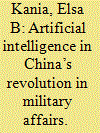

|
|
|
|
|
| Summary/Abstract |
The People’s Liberation Army (PLA) seeks not only to equal but also to overtake the US military through seizing the initiative in the ongoing Revolution in Military Affairs (RMA). Chinese military leaders believe the form of warfare is changing from today’s ‘informatised’ (信息化) warfare to future ‘intelligentised’ (智能化) warfare. The PLA’s approach to leveraging emerging technologies is likely to differ from parallel American initiatives because of its distinct strategic culture, organisational characteristics, and operational requirements. This research examines the evolution of the PLA’s strategic thinking and concepts of operations, seeking to contribute to the military innovation literature by evaluating major theoretical frameworks for the case of China.
|
|
|
|
|
|
|
|
|
|
|
|
|
|
|
|
| 2 |
ID:
172574


|
|
|
|
|
| Summary/Abstract |
There has been speculation for some time that unmanned ground vehicles (UGVs) are poised to revolutionize military land operations. These expectations have amplified with recent developments, not least the reported deployment and testing of Russian weaponized UGVs in Syria. Yet when it comes to the operational use of mobile ground-based robots – armed or otherwise – the recent history of the technology can be described as one of promise so far unfulfilled. By tracing past and present efforts to develop and field UGVs – and the enduring challenges that lie therein – this article attempts to gauge the likely impact of such systems in future conflict, as well as their effect on international security more broadly. The article concludes that although UGVs will almost certainly become a major – if not indispensable – feature of future military land operations, they will, similar to other promising militarily relevant technologies before them, continue to produce unrealistic expectations about their impending revolutionary effect.
|
|
|
|
|
|
|
|
|
|
|
|
|
|
|
|
| 3 |
ID:
111153
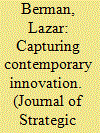

|
|
|
|
|
| Publication |
2012.
|
| Summary/Abstract |
The question of what enables some militaries to innovate effectively is of great interest to both scholars and commanders. However, the traditional models of military innovation fail to capture the complex innovation process. This study develops a new analytical framework that examines the pressures on and incentives for military innovation in the international, civil/military, organizational, and cultural planes and uses it to evaluate Israel Defense Forces (IDF) innovation between 2000 and 2009. Based on interviews with Israeli commanders and extensive research in Israel, this work finds that the IDF struggled to innovate before the 2006 war against Hizballah, but innovated effectively after the conflict once military and civilian leaders understood threats similarly. New models are needed to analyze the contemporary multi-dimensional innovative process.
|
|
|
|
|
|
|
|
|
|
|
|
|
|
|
|
| 4 |
ID:
117950


|
|
|
|
|
| Publication |
2012.
|
| Summary/Abstract |
Using the German Army from 1916 to 1918 as a case study, this article demonstrates a different form of military innovation than has hitherto been analysed by literature on the subject. During World War I, the German Army innovated by spreading knowledge between units rather than up and downthe chain of command. Thus, this army used 'horizontal innovation', rather than vertical innovation to change how it fought in the midst of battle. Although combat in World War I is significantly different from operations today, horizontal innovation offers armed forces a means by which to transform themselves much more rapidly than the traditionally recognised forms of military innovation.
|
|
|
|
|
|
|
|
|
|
|
|
|
|
|
|
| 5 |
ID:
105078


|
|
|
|
|
| Publication |
2011.
|
| Summary/Abstract |
This article views China's development of anti-access capabilities against the backdrop of the theory and history of military innovation. It begins with a discussion of the process of military innovation, as well as the indicators that may appear at different stages of that process. It then discusses the barriers to recognizing new ways of war and applies that framework to China's development of advanced ballistic missiles, to include precision-guided conventional ballistic missiles and anti-ship ballistic missiles (ASBMs). It concludes with several suggestions for how to improve the ability to recognize and understand foreign military innovation.
|
|
|
|
|
|
|
|
|
|
|
|
|
|
|
|
| 6 |
ID:
170775


|
|
|
|
|
| Summary/Abstract |
The Chinese People’s Liberation Army (PLA) anticipates that today’s advances in emerging technologies, particularly artificial intelligence, could catalyse a new military revolution. Elsa B Kania explores how, fearing surprise and seeking strategic opportunity, the PLA is actively pursuing military innovation and exploring new paradigms of military power.
|
|
|
|
|
|
|
|
|
|
|
|
|
|
|
|
| 7 |
ID:
185349
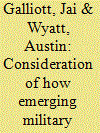

|
|
|
|
|
| Summary/Abstract |
The rapidly emerging scholarly literature responding to autonomous weapon systems has come to dominate our perceptions of future warfare. Scientists, governments, militaries, and civil society organisations continue to debate how to respond to their development. This paper draws on empirical data to consider how emerging defence leaders in the Australian Defence Force perceive major elements and questions within the autonomous weapon system literature. In doing so, this paper offers a data-driven end-user interpretation of the potential interactions between military officers and the autonomous weapon systems they may be asked to oversee. In the absence of a pre-emptive ban under international law, this paper presents a call for greater engagement with junior military leadership as a tool for analysing the assumptions made by policy makers and politicians on this issue.
|
|
|
|
|
|
|
|
|
|
|
|
|
|
|
|
| 8 |
ID:
072681
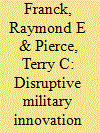

|
|
|
| 9 |
ID:
190866


|
|
|
|
|
| Summary/Abstract |
The aim of this article is to add an air power perspective to the innovation field, with emphasis on the development of jet fighters. Contemporary theory has not adequately addressed air power-related significant innovation, a shortcoming this article addresses. Using in-depth qualitive research methodology with eight diverse case-studies in the Cold War period, we show that innovation of jet fighters was typically initiated in response to hegemonic tensions, immediate threats and organsational factors such as civil–military relations, bureaucratic politics, and air force innovation culture. Moreover, through a comparative analysis we argue that significant and successful air power innovation is achieved through proficiency and knowledge gained by constant learning of air power theory and bottom-up innovation mechanisms. Looking forward, this study may be significant for assisting military professionals in making better-informed decisions about the use of fifth-generation air power by implementing past lessons learned into contemporary theory and future plans.
|
|
|
|
|
|
|
|
|
|
|
|
|
|
|
|
| 10 |
ID:
192532
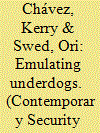

|
|
|
|
|
| Summary/Abstract |
Early studies on state drone proliferation argued that it would be temperate, constrained by high financial, technical, and infrastructural requisites and fielded according to the logic of scarce, exquisite airpower. While this rationale has held for limited conflicts, the high attrition and massive demand of a total war compelled strong standing armies to follow a different model of adoption: emulating weaker violent nonstate actors leveraging low-cost commercial platforms. The Russia-Ukraine war has captured this trend. Despite earlier expectations of armies maintaining advanced airpower for strategic ends, underdog Ukraine, followed by Russia have developed heavy reliance on commercial drone technologies for tactical aims. Framing this in military and battlefield innovation literature and drawing on studies on commercial drone use among violent nonstate actors, we argue that this constitutes a new trajectory involving mixed military arsenals enhanced with dual-use commercial platforms.
|
|
|
|
|
|
|
|
|
|
|
|
|
|
|
|
| 11 |
ID:
190703
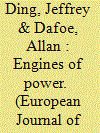

|
|
|
|
|
| Summary/Abstract |
Major theories of military innovation focus on relatively narrow technological developments, such as nuclear weapons or aircraft carriers. Arguably the most profound military implications of technological change, however, come from more fundamental advances arising from ‘general-purpose technologies’ (GPTs), such as the steam engine, electricity, and the computer. Building from scholarship on GPTs and economic growth, we argue that the effects of GPTs on military effectiveness are broad, delayed, and shaped by indirect productivity spillovers. We label this impact pathway a ‘general-purpose military transformation’ (GMT). Contrary to studies that predict GPTs will rapidly diffuse to militaries around the world and narrow gaps in capabilities, we show that GMTs can reinforce existing balances if leading militaries have stronger linkages to a robust industrial base in the GPT than challengers. Evidence from electricity's impact on military affairs, covering the late nineteenth and early twentieth centuries, supports our propositions about GMTs. To probe the explanatory value of our theory and account for alternative interpretations, we compare findings from the electricity case to the military impacts of submarine technology, a non-GPT that emerged in the same period. Finally, we apply our findings to contemporary debates about artificial intelligence, which could plausibly cause a profound GMT.
|
|
|
|
|
|
|
|
|
|
|
|
|
|
|
|
| 12 |
ID:
151423
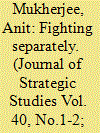

|
|
|
|
|
| Summary/Abstract |
How do countries transition from single service to joint operations? This article engages with the discussion on military innovation to argue that civil–military relations are the most important driver for jointness. In doing so it examines jointness in the Indian military. Relying on archival research and primary interviews this article sheds new light on the operations of the Indian Peacekeeping Forces (IPKF) in Sri Lanka from 1987–1990, the 1999 Kargil War and the Post-Kargil defence reforms. The main argument is that the Indian military’s transition to jointness has been ‘incomplete’ primarily because of its prevailing model of civil-military relations. This model prevents civilians from interfering in the operational issues of the military, including on matters pertaining to jointness. It therefore recommends more forceful civilian intervention to overcome the prevailing single service approach.
|
|
|
|
|
|
|
|
|
|
|
|
|
|
|
|
| 13 |
ID:
179505
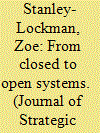

|
|
|
|
|
| Summary/Abstract |
The return to strategic competition affects the US military services differently, but all are contending with the challenge of renewing their military advantage against near-peer, technologically advanced competitors. Commercially driven innovation trends simultaneously challenge the way that the US military manages technology. This article traces the pursuits to institutionalise open innovation practices inside the services to incorporate emerging technologies into their envisaged competitive advantage. Rather than treating the US military as a monolithic entity, this article assesses how new service-level organisations differ in the ways and means they pursue innovation and seeks to explain why those differences persist.
|
|
|
|
|
|
|
|
|
|
|
|
|
|
|
|
| 14 |
ID:
074101
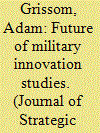

|
|
|
|
|
| Publication |
2006.
|
| Summary/Abstract |
This article assesses the state of the art in military innovation research. It begins with a description of the field's four major schools of thought, summarizing their central tenets, key points of similarity and differentiation, and major empirical cases. It then addresses priorities for future research, observing that while much has been learned about innovation originating among senior officers and civilian policy-makers, far less is known about innovation originating in field formations. Recent empirical studies hint at the importance of such bottom-up innovation but little progress has been made in achieving a conceptual understanding of the phenomenon. Therein lies the next major challenge, and opportunity, for the field.
|
|
|
|
|
|
|
|
|
|
|
|
|
|
|
|
| 15 |
ID:
151611


|
|
|
|
|
| Summary/Abstract |
When it comes to creating new battlefield concepts and capabilities, buying cutting-edge machines is not enough.
|
|
|
|
|
|
|
|
|
|
|
|
|
|
|
|
| 16 |
ID:
114960
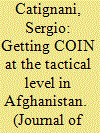

|
|
|
|
|
| Publication |
2012.
|
| Summary/Abstract |
This article reassesses the extent to which the British Army has been able to adapt to the counter-insurgency campaign in Helmand Province, Afghanistan. While adopting Farrell's definition of bottom-up military adaptation, this article contends that the task force/brigade level of analysis adopted by Farrell and Farrell and Gordon has led them to overstate the degree to which innovation arising from processes of bottom-up adaptation has actually ensued. Drawing on lower level tactical unit interviews and other data, this article demonstrates how units have been unable or unwilling to execute non-kinetic population-centric operations due to their lack of understanding of the principles of counter-insurgency warfare.
|
|
|
|
|
|
|
|
|
|
|
|
|
|
|
|
| 17 |
ID:
116067


|
|
|
|
|
| Publication |
2012.
|
| Summary/Abstract |
Facing nearly half a billion dollars in spending cuts over the next five years, US defense planners and strategists must simultaneously rebuild a war-weary Army weakened from over a decade of war, build new sea and air capabilities for the Pacific theater, and reduce manpower, procurement, and contractor budgets while promoting innovation. The US defense department is embarking on what may be the most sweeping period of defense transformation in recent memory. This article reviews the history of American defense transformation, focusing on an important but largely overlooked period of military innovation that began in the shadow of Vietnam and ended with troops fighting through blinding sandstorms at night on the road to Baghdad. The multifaceted transformation strategy conceived in the 1970s paved the way for a military revolution in the 1990s and enabled unprecedented battlefield adaptation in the 2000s. After reviewing the revolutionary changes that led to American dominance in conventional warfare in the 1990s, the article examines US transformation policies in the 2000s to inform defense strategy and planning efforts in the 2010s.
|
|
|
|
|
|
|
|
|
|
|
|
|
|
|
|
| 18 |
ID:
158954


|
|
|
|
|
| Summary/Abstract |
States generate the hardware of military power by either developing new technologies as first mover or adopting demonstrated technology as second mover. Given that military drones have arguably demonstrated effectiveness and thus proliferate, scholars have produced profound insights into today’s second mover dynamics. Yet, the preceding political process of developing this military technology remains poorly understood. The article’s objective is to explain how states become first movers of military hardware. To this end, it applies four causal mechanisms of military innovation studies to the historical trajectory of the development of drones. I argue that security threats initially formed state interests in drones. Yet, capacity was necessary for success. Politically induced transfers and cross-sector diffusion supplied technological progress. At the same time, distributional implications and legacy systems constrained the development process, but could ultimately be overcome. This mechanismic pathway results from the process-tracing analysis of two separate, but related trajectories in Israel and the United States since the 1970s. Given within-case variation, a sequencing and domain-of-application perspective allows the formulation of scope conditions of the mechanisms behind military innovation. This contributes to a historically contingent, yet generalisable, understanding of the political process of how states generate military power.
|
|
|
|
|
|
|
|
|
|
|
|
|
|
|
|
| 19 |
ID:
098453
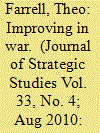

|
|
|
|
|
| Publication |
2010.
|
| Summary/Abstract |
War disciplines militaries: it forces them to refine, and sometimes revise, their tactics, techniques and technologies, or risk defeat in battle. Yet there is no theory of how militaries improve in war. This article develops a theory of military adaptation, which it applies to an analysis of the British campaign in Helmand from 2006 to 2009. Drawing on a wealth of primary sources (military plans, post operation reports and interviews), it shows how British brigades adapted different ways of using combat power to try and defeat the Taliban from 2006-07, and how from late 2007, British brigades have adapted a new population-centric approach that has focused more on influence operations and non-kinetic activities.
|
|
|
|
|
|
|
|
|
|
|
|
|
|
|
|
| 20 |
ID:
074805
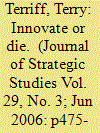

|
|
|
|
|
| Publication |
2006.
|
| Summary/Abstract |
The purpose of this article is twofold. First, this article contributes to the understanding of the origins of maneuver warfare as the capstone doctrine of the Marine Corps. It does so by identifying a second source that fostered change in the Marine Corps - one in addition to disquiet about the conduct of the war in Vietnam - which stemmed from the challenges posed by the United States' post-Vietnam strategic and military reorientation. And second, this article examines the influence of organizational culture, or identity, on innovation in the Marine Corps. A critical strand in the growing literature on military innovation focuses on organizational culture and how it influences the behavior and responses of particular military organizations. This article contributes to this literature by analyzing the influence of the organizational culture of the Marine Corps in shaping what was deemed an appropriate response to the challenges it confronted in the 1970s.
|
|
|
|
|
|
|
|
|
|
|
|
|
|
|
|
|
|
|
|
|